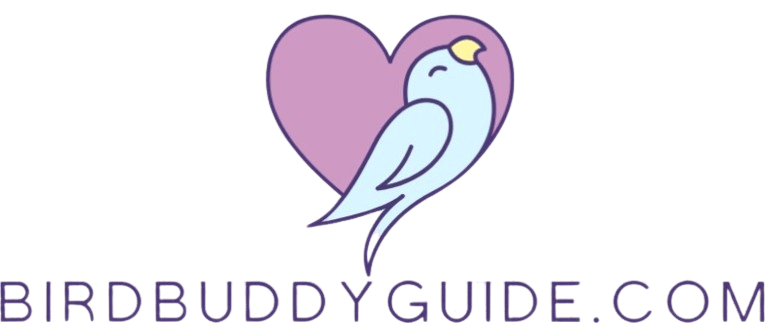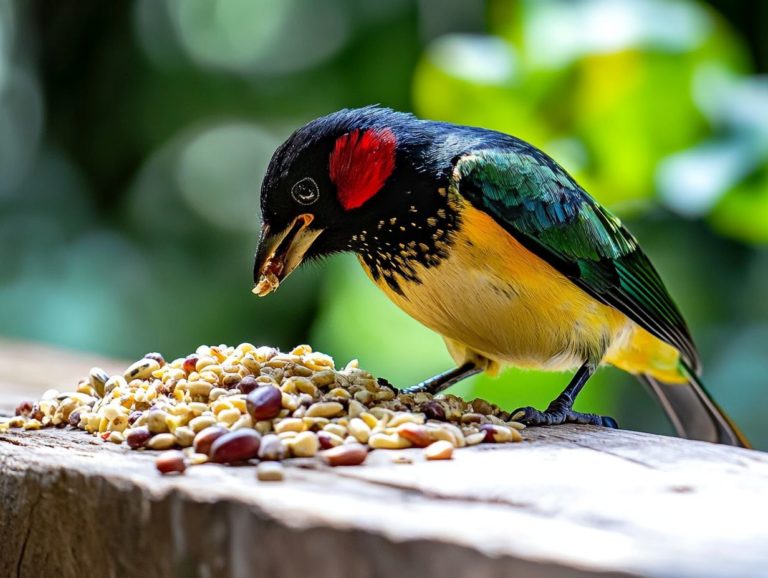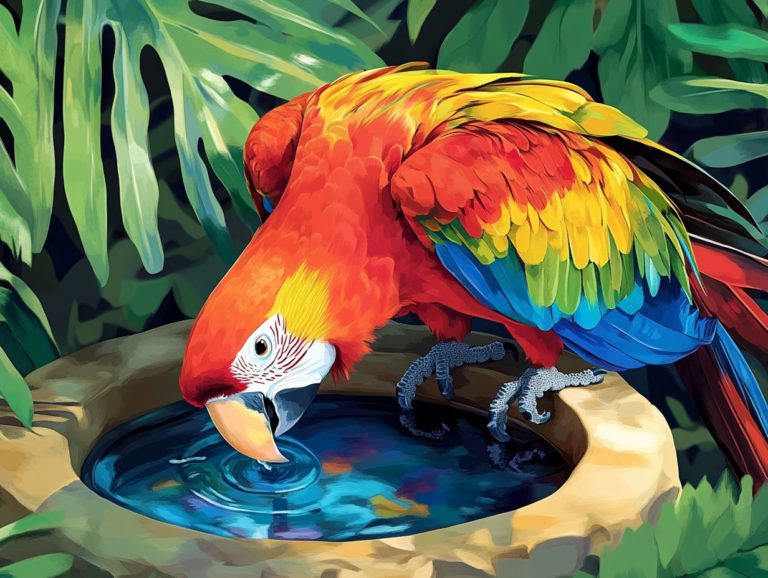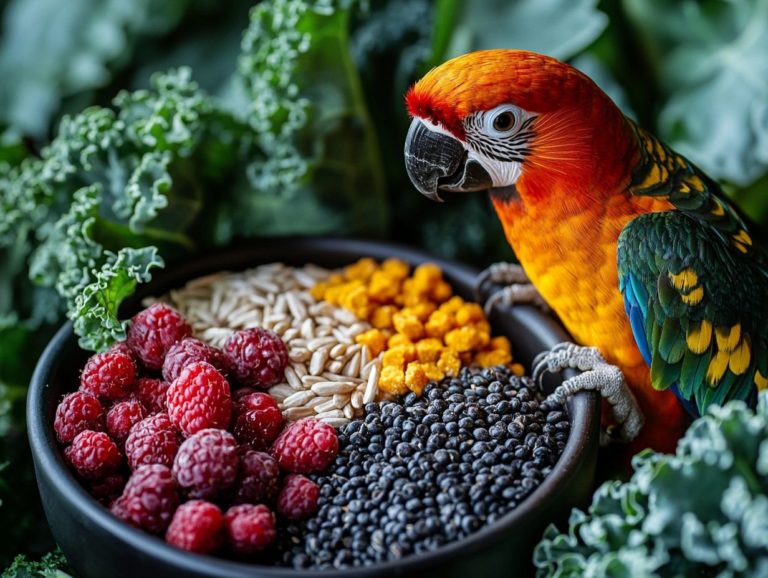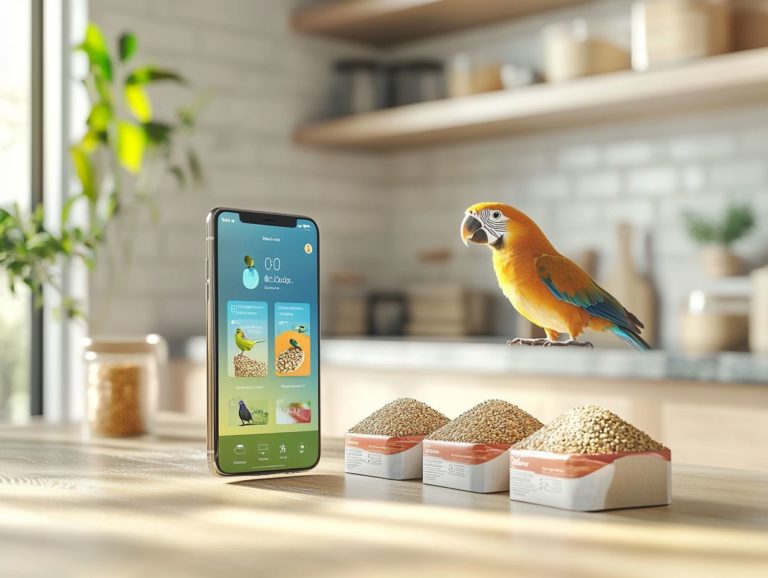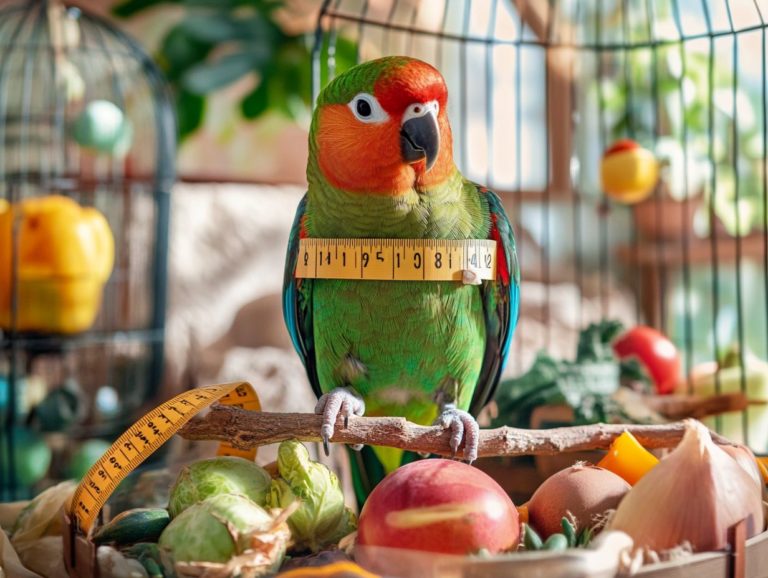How to Transition Pet Birds to New Foods
Feeding your pet bird a balanced and nutritious diet is essential for their overall health and well-being. With a variety of food options at your disposal, it’s important to grasp their specific nutritional needs and the advantages of introducing new food choices that support their physical health and mental well-being.
Whether you re contemplating a gradual transition or a more immediate overhaul, this guide will equip you with the steps to effectively introduce new foods, navigate common challenges, and uphold a healthy balanced diet for your feathered companion.
Discover the best practices for ensuring your pet bird not only survives but thrives while maintaining a proper diet that includes seeds, fresh foods, and high-quality pellets.
Contents
- Key Takeaways:
- Understanding Your Pet Bird’s Diet
- Reasons for Transitioning to New Foods
- Steps to Transitioning Your Pet Bird’s Diet
- Common Challenges and Solutions
- Maintaining a Healthy Diet for Your Pet Bird
- Frequently Asked Questions
- What is the best way to transition my pet birds to new foods?
- What fruits and vegetables are safe for my pet bird?
- Why is it important to transition my pet birds to new foods?
- Can I switch my pet birds to a new food immediately?
- How do I know if my pet birds are not adjusting well to the new food?
- Can I mix multiple new foods together when transitioning my pet birds?
- How long should I continue the transition process for my pet birds?
Key Takeaways:

- Gradually introduce new foods to your pet bird to avoid sudden changes in their diet.
- Consider transitioning to new foods if your pet bird shows signs of a lack of important nutrients or if you want to provide a more balanced diet.
- Maintain a healthy and varied diet for your pet bird by offering a mix of seeds, fresh foods, fruits, vegetables, and pellets daily.
Understanding Your Pet Bird’s Diet
Understanding your pet bird’s diet is essential for maintaining their overall health and well-being. Birds, such as cockatiels and parakeets, thrive on a diet that includes a variety of food groups to support their mental and physical health. This is especially important when transitioning from a seed diet.
A balanced diet should mainly include high-quality pellets and fresh foods. Add a measured portion of seeds for variety, ensuring they receive the vital nutrients necessary for a long and joyful life, including essential vitamins such as vitamin A.
Types of Foods and Nutritional Needs
A well-rounded diet for your pet bird involves a delightful array of foods tailored to meet their unique nutritional needs. These needs can differ significantly across species such as cockatiels, parakeets, and parrots.
To ensure your feathered friend receives vital nutrients, it s essential to offer a mix of seeds, high-quality pellets such as Zupreem and Lafeber, and fresh produce from the pet store. Options may include apple, banana, and grapes. Seeds might be their favorite snack, but balancing them with nutrient-dense options is key.
Fresh vegetables think carrots, kale, and bell peppers are fantastic sources of vitamin A, which is crucial for maintaining good vision and a robust immune system. Overlooking these essential nutrients can lead to vitamin deficiencies that jeopardize their well-being.
This could potentially result in issues like feather plucking or lethargy requiring medical attention. By incorporating a diverse selection of foods into their diet, you’ll promote both longevity and a vibrant zest for life in your avian companion.
Reasons for Transitioning to New Foods
Transitioning your pet bird to new foods is vital! It boosts their health and prevents nutrient shortages, promoting both their mental health and physical well-being, especially in birds that previously relied on a seed diet.
Ensuring a varied diet can significantly elevate your bird s quality of life, making this change an important step in their care. Start the transition today for a healthier, happier bird!
Benefits and When to Consider Transitioning
Transitioning your pet bird’s diet offers numerous benefits, including enhanced mental stimulation, improved physical health, and prevention of health-related issues often linked to a seed-heavy diet low in essential nutrients. By embracing a varied menu, you can expect your feathered friend to burst with energy and become more active and engaged with their environment.
A well-rounded nutritional choice leads to better feather condition, showcasing vibrant colors and a pleasing texture. Shifting to a healthier diet can also strengthen your bird s immune system, reducing the risk of illness.
Look for signs that indicate a need for this dietary change: decreased activity, dull feathers, and an overall lack of energy.
To make the transition easier, get creative with your feeding strategies by incorporating pureed fruits and vegetables into their meals. Consider offering colorful fruits and vegetables, blending in high-quality pellets, or introducing foraging toys that encourage natural feeding behaviors. This way, your pet can receive the essential vitamins and minerals required for optimal health.
Steps to Transitioning Your Pet Bird’s Diet
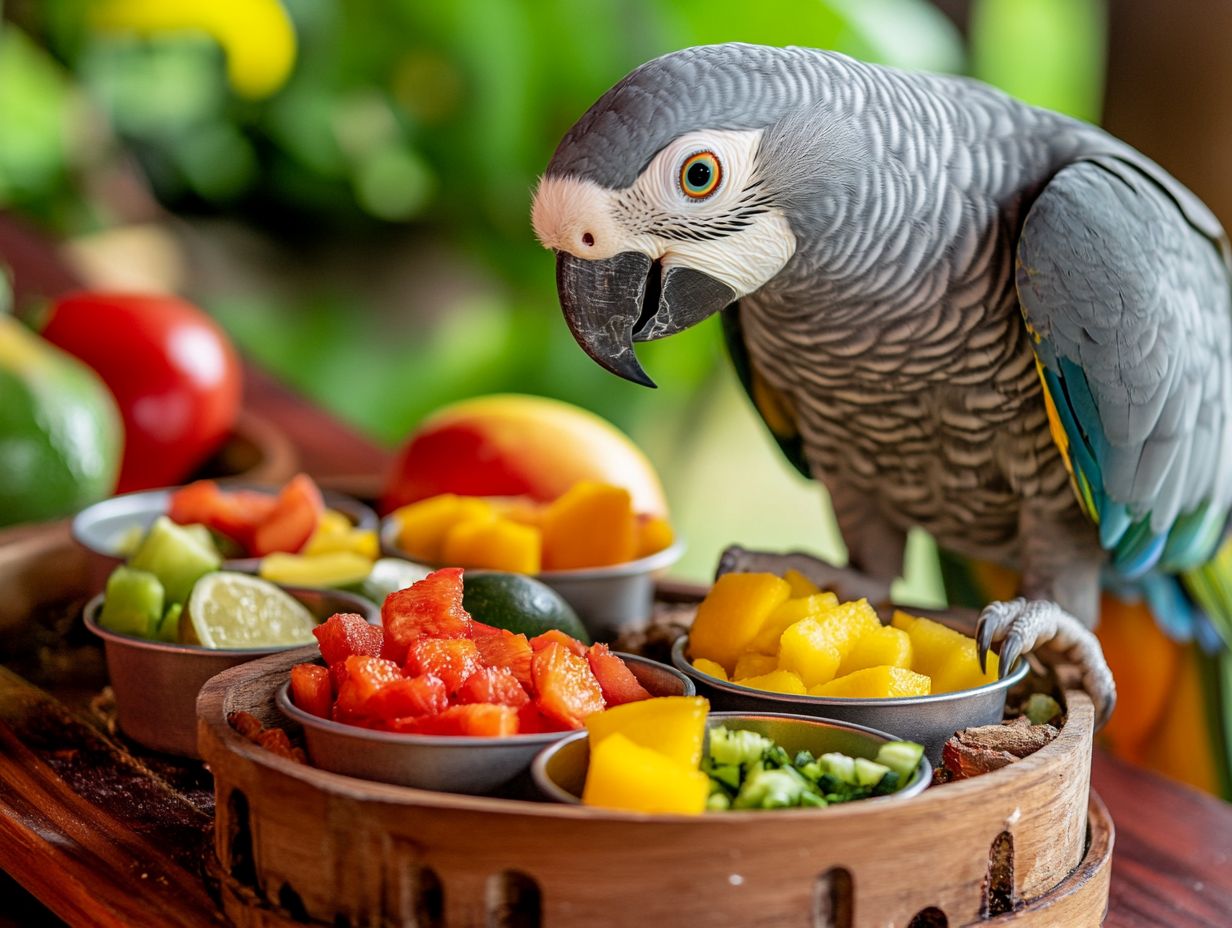
Transitioning your pet bird’s diet requires a careful and thoughtful approach. It’s essential to make it easy to switch to a healthy, balanced diet that includes a variety of nutritious options.
Gradual vs. Immediate Changes
When considering changes to your pet bird’s diet, it’s crucial to understand the benefits of gradual versus immediate changes, as both approaches have advantages and challenges.
Gradual transitions are typically best for sensitive species. They allow your bird to acclimate to new textures and flavors, minimizing potential digestive issues and stress. However, there are instances where swift dietary changes are necessary, such as introducing essential vitamins or eliminating harmful ingredients from their current diet. In such cases, closely monitor your bird’s reactions and adjust as needed.
By finding the right balance between these methods, you can ensure a healthier diet conversion process, incorporating fresh vegetables, high-quality pellets, or new foraging experiences.
Introducing New Foods
Introducing new foods to your pet bird’s diet can be a delightful journey when approached with creativity and patience. This exploration allows you and your feathered friend to discover fresh and nutritious options together.
One effective strategy is to blend pureed fruits and vegetables into their meals, especially for birds hesitant about unfamiliar textures. By pureeing the produce, you make it easier for them to accept new tastes without feeling overwhelmed. Consistency is vital; having a regular schedule for introducing these foods helps your bird adapt gradually.
Presenting the purees in a variety of fun shapes or using colorful feeding dishes can spark their curiosity and encourage them to explore new flavors. This playful approach promotes gradual exposure, opening the door to a more diverse diet and enhancing their overall health and quality of life.
Common Challenges and Solutions
Navigating the complexities of dietary transitions for pet birds can be overwhelming. You may encounter challenges like refusals to eat or the risk of nutritional deficiencies, which may require medical attention if the situation worsens.
Dealing with Refusal to Eat
Dealing with a pet bird s stubbornness when trying new foods can be quite the challenge. However, you can turn this frustration into an opportunity by employing creative feeding techniques that encourage exploration and diversify their diet.
One effective strategy is to present foods in a variety of forms pureed, chopped, or even whole. This helps you discover which texture your feathered friend prefers, ensuring they get the nutrients they need. Mixing familiar favorites with new options gently introduces changes without overwhelming them.
Presentation matters. Vibrant colors and intriguing shapes can make meals irresistibly appealing, especially when including fruits like peanut butter, apples, or grapes. Exercise patience and remain observant throughout this journey. Some birds may need time to warm up to unfamiliar tastes. Monitoring their reactions will provide valuable insights, allowing you to refine your approach and conquer common feeding challenges.
Addressing Nutritional Deficiencies
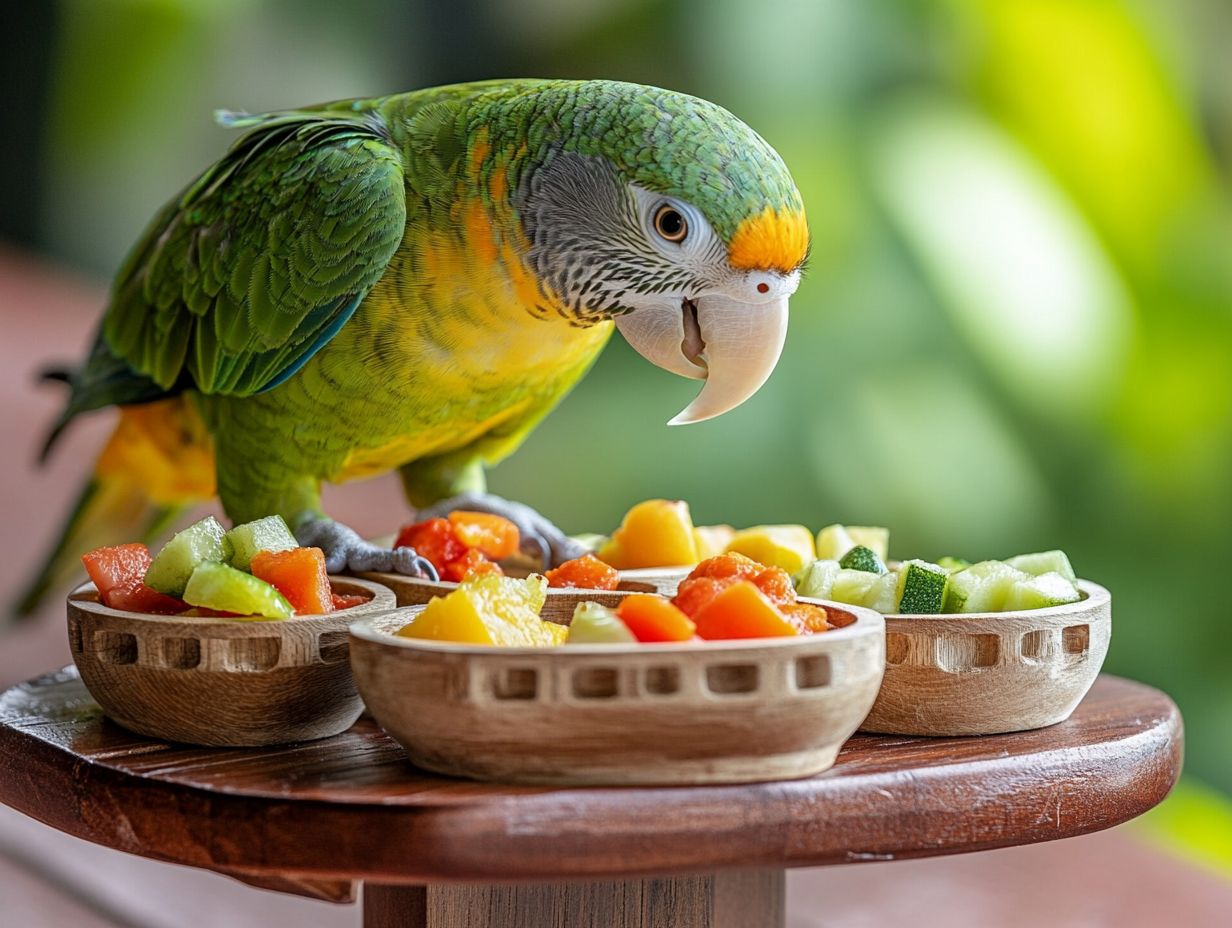
Addressing nutritional deficiencies in your pet bird is essential for their long-term health. You need to pay attention right away, especially if you notice symptoms of vitamin deficiency such as poor feather condition. Ignoring these signs could lead to serious health complications that affect their energy levels and overall well-being.
Changes in behavior can signal deeper issues, so careful observation is vital to prevent minor problems from escalating into major health concerns. Common signs of nutritional deficiencies include feather plucking, lethargy, and a dull appearance, suggesting a lack of essential vitamins and minerals.
For example, a vitamin A deficiency might result in respiratory issues and poor feather quality, while a calcium deficiency can lead to weak bones and egg-binding in breeding females.
To address these gaps, supplement their diet with fresh fruits like grapes, leafy greens, and specialized pellets. Opt for organic brands if possible. If symptoms persist despite dietary adjustments, consult a veterinarian who specializes in bird health to rule out serious conditions.
Maintaining a Healthy Diet for Your Pet Bird
Maintaining a healthy diet for your pet bird requires a commitment to consistent nutrition practices and dedication to offering a well-rounded selection of foods that meet their distinct dietary needs.
Tips for Long-Term Success
To achieve long-term success in maintaining a healthy, balanced diet for your pet bird, consider embracing various tips focused on nutrition feeding and regularly introducing fresh foods.
Meal planning is a crucial first step. This allows you to incorporate diverse fruits, vegetables, and seeds that align with your bird’s species and individual preferences. By monitoring your pet s food intake, you can easily spot dietary deficiencies or tendencies toward overindulgence.
Staying informed about the latest dietary research equips you with insights into emerging trends that could elevate your bird’s wellness. Exploring creative feeding methods like foraging toys and bird-safe feeders keeps mealtime exciting and fosters mental stimulation.
Embracing sustainable feeding practices, such as choosing organic produce, supports a healthier environment that benefits both your feathered companion and the planet.
Frequently Asked Questions
What is the best way to transition my pet birds to new foods?
The best way to transition your pet birds to new foods is to do it gradually. Start by mixing a small amount of the new food with their current food and gradually increase the ratio over a week or two until they are completely eating the new food.
What fruits and vegetables are safe for my pet bird?
Safe fruits and vegetables for pet birds include apples, carrots, spinach, and berries. Always ensure that any food is fresh and free from pesticides.
Start today to give your bird a healthy, varied diet!
Why is it important to transition my pet birds to new foods?
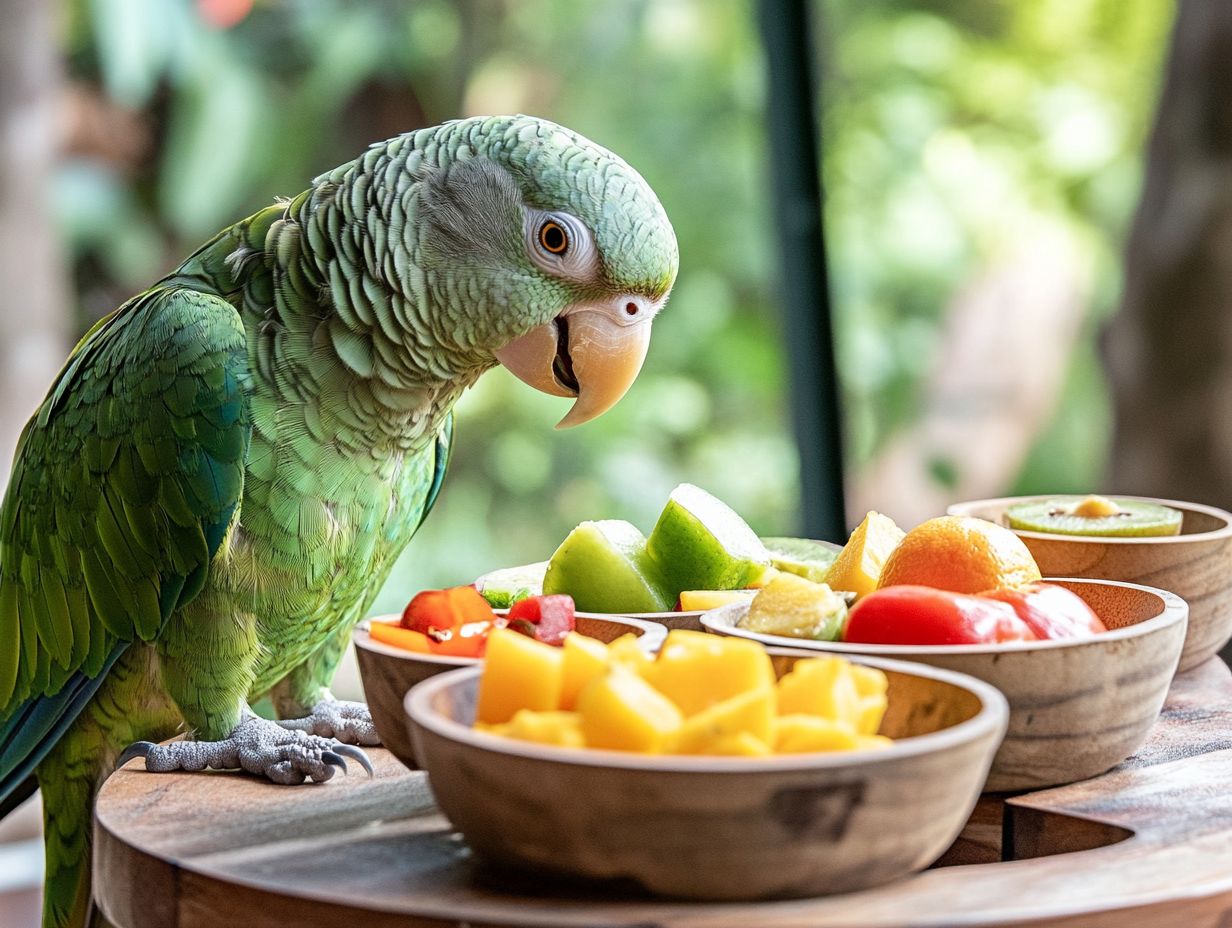
Transitioning your pet birds to new foods is essential. It allows their digestive system to adjust to the new food and prevents sudden changes that could upset their stomachs.
This process also helps ensure they receive a well-rounded and nutritious diet, which is vital for their overall well-being.
Can I switch my pet birds to a new food immediately?
No, do not switch your pet birds to a new food immediately. A sudden change can cause digestive upset and may lead to your birds eating less or refusing the new food.
Gradual transitions are best for their health and well-being.
How do I know if my pet birds are not adjusting well to the new food?
If your pet birds are struggling with the new food, they may show signs such as eating less, weight loss, or changes in their droppings.
If you notice any of these signs, reach out to your vet for expert advice on how to proceed.
Can I mix multiple new foods together when transitioning my pet birds?
Do not mix multiple new foods when transitioning your pet birds. Doing so can complicate identifying which food may cause any potential issues or digestive upset.
Introduce one new food at a time and monitor their response before adding another new food.
How long should I continue the transition process for my pet birds?
The length of the transition process varies between birds. Some may adjust quickly, while others take longer.
It is crucial to monitor your birds’ response and make adjustments as needed. If you have concerns, consult with your vet for guidance.
